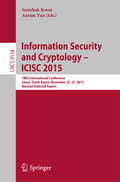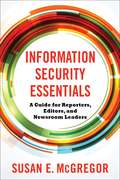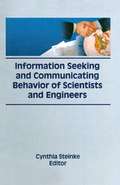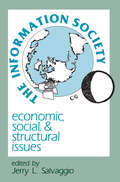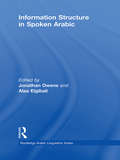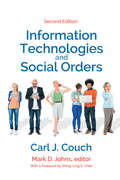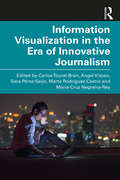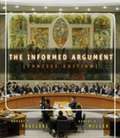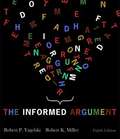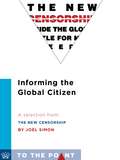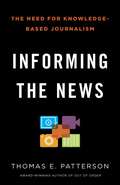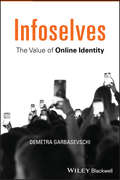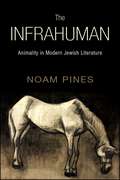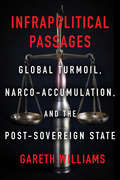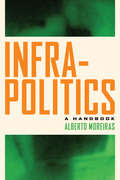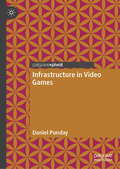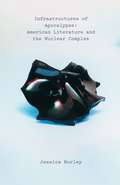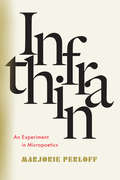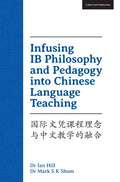- Table View
- List View
Information Security and Cryptology - ICISC 2015
by Soonhak Kwon Aaram YunThis book constitutes the thoroughly refereedpost-conference proceedings of the 18th International Conference on InformationSecurity and Cryptology, ICISC 2015, held in Seoul, South Korea, in November2015. The 23 revised full papers presented were carefullyselected from 84 submissions during two rounds of reviewing and improvement. The papers provide the latest results in research, development and applicationsin the field of information security and cryptology. They are grouped aroundthe following topics: digital signatures; public-key cryptography; block ciphercryptanalysis; elliptic curve cryptography; protocols; security; side-channelattacks.
Information Security Essentials: A Guide for Reporters, Editors, and Newsroom Leaders
by Susan E. McGregorAs technological and legal changes have hollowed out the protections that reporters and news organizations have depended upon for decades, information security concerns facing journalists as they report, produce, and disseminate the news have only intensified. From source prosecutions to physical attacks and online harassment, the last two decades have seen a dramatic increase in the risks faced by journalists at all levels even as the media industry confronts drastic cutbacks in budgets and staff. As a result, few professional or aspiring journalists have a comprehensive understanding of what is required to keep their sources, stories, colleagues, and reputations safe.This book is an essential guide to protecting news writers, sources, and organizations in the digital era. Susan E. McGregor provides a systematic understanding of the key technical, legal, and conceptual issues that anyone teaching, studying, or practicing journalism should know. Bringing together expert insights from both leading academics and security professionals who work at and with news organizations from BuzzFeed to the Associated Press, she lays out key principles and approaches for building information security into journalistic practice. McGregor draws on firsthand experience as a Wall Street Journal staffer, followed by a decade of researching, testing, and developing information security tools and practices. Filled with practical but evergreen advice that can enhance the security and efficacy of everything from daily beat reporting to long-term investigative projects, Information Security Essentials is a vital tool for journalists at all levels.
Information Seeking and Communicating Behavior of Scientists and Engineers
by Cynthia SteinkeThis inspiring book addresses a topic that is far too often ignored or disregarded by sci-tech librarians: Exactly how do scientists and engineers really discover, select, and use the countless information and communications resources available to them when conducting research? The answer to this question should be a major influence on the way information specialists develop information systems in their libraries. Unfortunately, many librarians are not as familiar with the work, information needs, and communicating behavior of the research worker. Information Seeking and Communications Behavior of Scientists and Engineers looks at this question from several perspectives to give an overall view of how to best serve the needs of the scientific community.This book is an encouragement and a challenge to sci-tech librarians to make an ever greater effort to understand the work of their users, the differing information channels and sources they employ, and thus tailor the library’s systems and services to best support their information-seeking behavior.
The Information Society: Economic, Social, and Structural Issues (Routledge Communication Series)
by Jerry L. SalvaggioFirst Published in 1989. Routledge is an imprint of Taylor & Francis, an informa company.
Information Structure in Spoken Arabic (Routledge Arabic Linguistics Series)
by Jonathan OwensThis book explores speakers’ intentions, and the structural and pragmatic resources they employ, in spoken Arabic – which is different in many essential respects from literary Arabic. Based on new empirical findings from across the Arabic world this book elucidates the many ways in which context and the goals and intentions of the speaker inform and constrain linguistic structure in spoken Arabic. This is the first book to provide an in-depth analysis of information structure in spoken Arabic, which is based on language as it is actually used, not on normatively-given grammar. Written by leading experts in Arabic linguistics, the studies evaluate the ways in which relevant parts of a message in spoken Arabic are encoded, highlighted or obscured. It covers a broad range of issues from across the Arabic-speaking world, including the discourse-sensitive properties of word order variation, the use of intonation for information focussing, the differential role of native Arabic and second languages to encode information in a codeswitching context, and the need for cultural contextualization to understand the role of "disinformation" structure. The studies combine a strong empirical basis with methodological and theoretical issues drawn from a number of different perspectives including pragmatic theory, language contact, instrumental prosodic analysis and (de-)grammaticalization theory. The introductory chapter embeds the project within the deeper Arabic grammatical tradition, as elaborated by the eleventh century grammarian Abdul Qahir al-Jurjani. This book provides an invaluable comprehensive introduction to an important, yet understudied, component of spoken Arabic.
Information Technologies and Social Orders (Communication And Social Order Ser.)
by Carl J. CouchAccording to Carl J. Couch, the history of human society is one of successive, sometimes overlapping, information technologies used to process the various symbolic representations that inform social contexts. Unlike earlier “media” theorists who ignored social context in order to concentrate on the information technologies themselves, Couch implements a consistent theory of interpersonal and intergroup relations to describe the essential interface between information technologies and the social contexts in which they are used. Couch emphasizes the formative capacities of information technologies across historical epochs and cultures, and places them within the major institutional relations of various societies. He views social orders as reflexively shaped by the information technologies that participants use, and as susceptible to mass brutality and oppression due to oligarchic control though he hopes technology will remain humane. The original edition of this manuscript was nearly complete at the time of Couch’s death and was brought to completion by two of his closest associates. Now after two decades, during which its impact is indisputable, it has been updated for a new generation of students and scholars. Additions include discussions on books in the digital age, social media, mobile telephones, recordings, participatory culture, and more.
Information Visualization in The Era of Innovative Journalism
by Carlos Toural-BranInformation Visualization in the Era of Innovative Journalism brings together over 30 authors from countries around the world to synthesize how recent technological innovations have impacted the development, practice and consumption of contemporary journalism. As technology rapidly progresses, shifts, and innovates, there have been immense changes in the way we communicate. This book collects research from around the world that takes an in-depth look at the primary transformations related to journalistic innovation in recent times. High-profile contributors provide cutting-edge scholarship on innovation in journalism as it relates to emergent topics such as virtual reality, podcasting, multimedia infographics, social media, mobile storytelling and others. The book pays special attention to the development of information visualization and the ability of recent innovations to meet audience needs and desires. Students and scholars studying contemporary journalism history and practice will find this a vital and up-to-date resource, as well as those studying communication technology as it relates to marketing, PR or mass media broadly.
Informational Passages for Text Marking & Close Reading, Grade 3
by Marcia Miller Martin LeeHigh-interest reproducible informational passages provide text-marking practice that help students read closely, build comprehension skills, and meet higher standards.
The Informed Argument (Brief 6th Edition)
by Robert P. Yagelski Robert K. MillerFor those who don't want readings, the Brief Edition contains the rhetoric portion of The Informed Argument, 6th edition.
The Informed Argument (Eighth Edition)
by Robert P. Yagelski Robert Keith MillerTreating argument as a problem-solving tool, featuring an innovative marginalia program that contains the contextual information students need to enter thematic conversations, and providing the most extensive coverage of argument in all forms of media, THE INFORMED ARGUMENT is the complete solution for teaching writing and argument.
Informing the Global Citizen: A Selection from The New Censorship: Inside the Global Battle for Media Freedom (To the Point)
by Joel SimonToday, anyone with an iPhone can provide firsthand accounts from the world's front lines. Despite our increased access to events around the world, journalists are more vital than ever as they bring context and perspective and help to set the humanitarian agenda. However, threats to journalists are mounting with record numbers killed and imprisoned each year. From the drug wars of Mexico to Iraq and Tahrir Square, Joel Simon explores the new challenges and dangers to the future of journalistic freedom.
Informing the Global Citizen: Inside the Global Battle for Media Freedom
by Joel SimonToday, anyone with an iPhone can provide firsthand accounts from the world's front lines. Despite our increased access to events around the world, journalists are more vital than ever as they bring context and perspective and help to set the humanitarian agenda. However, threats to journalists are mounting with record numbers killed and imprisoned each year. From the drug wars of Mexico to Iraq and Tahrir Square, Joel Simon explores the new challenges and dangers to the future of journalistic freedom.
Informing the Global Citizen: Inside the Global Battle for Media Freedom
by Joel SimonToday, anyone with an iPhone can provide firsthand accounts from the world's front lines. Despite our increased access to events around the world, journalists are more vital than ever as they bring context and perspective and help to set the humanitarian agenda. However, threats to journalists are mounting with record numbers killed and imprisoned each year. From the drug wars of Mexico to Iraq and Tahrir Square, Joel Simon explores the new challenges and dangers to the future of journalistic freedom.
Informing the News
by Thomas E. PattersonAs the journalist Walter Lippmann noted nearly a century ago, democracy falters "if there is no steady supply of trustworthy and relevant news." Today's journalists are not providing it. Too often, reporters give equal weight to facts and biased opinion, stir up small controversies, and substitute infotainment for real news. Even when they get the facts rights, they often misjudge the context in which they belong. Information is the lifeblood of a healthy democracy. Public opinion and debate suffer when citizens are misinformed about current affairs, as is increasingly the case. Though the failures of today's communication system cannot be blamed solely on the news media, they are part of the problem, and the best hope for something better. Patterson proposes "knowledge-based journalism" as a corrective. Unless journalists are more deeply informed about the subjects they cover, they will continue to misinterpret them and to be vulnerable to manipulation by their sources. In this book, derived from a multi-year initiative of the Carnegie Corporation and the Knight Foundation, Patterson calls for nothing less than a major overhaul of journalism practice and education. The book speaks not only to journalists but to all who are concerned about the integrity of the information on which America's democracy depends.
Infoselves: The Value of Online Identity
by Demetra GarbasevschiInfoselves delivers a multifaceted analysis of the commodification of self-identity online, from both a domination and a liberation perspective. Drawing on multiple resources, the book places its discussion of online identity within the larger context of self-identity evolution, arguing for the recognition of online identity as a legitimate component of the self-identity system. Advertising executive turned academic, Demetra Garbașevschi offers readers the means to understand the way our online identities are formed and used, to reflect on the future of self-identity, and to become more aware of the radical implications of our digital footprint. Readers will discover what it means to be an infoself in a deep digital context, from exploring the informational makeup of self-identity, to examining the various sources of identity information found online, to exposing the uses of this information through both latent and assertive self-commodification. Considering the many sources of information contributing to our identity narrative online, some beyond our direct control, managing the self is presented as one the greatest challenges of our digital present. The book includes illuminating discussions of a variety of topics within the subject of online identity, such as: Foundational concepts related to the idea of identity, including references to the works of Erik Erikson, symbolic interactionists, and social dramaturgy The evolution of online identity, with examinations of early and current viewpoints of the phenomenon Personal branding online as the epitome of self-commodification, with examples from online celebrity, micro-celebrity, and nano-celebrity Original research contributing to the larger discussion about how identities are constructed and performed through-the-line Perfect for graduate students in advertising, branding, and public relations, Infoselves also belongs on the bookshelves of those studying fields involving digital media. Working professionals in any of these areas will also benefit from this book’s insightful analyses of a variety of viewpoints on online identity.
Infowhelm: Environmental Art and Literature in an Age of Data (Literature Now Ser.)
by Heather HouserHow do artists and writers engage with environmental knowledge in the face of overwhelming information about catastrophe? What kinds of knowledge do the arts produce when addressing climate change, extinction, and other environmental emergencies? What happens to scientific data when it becomes art? In Infowhelm, Heather Houser explores the ways contemporary art manages environmental knowledge in an age of climate crisis and information overload.Houser argues that the infowhelm—a state of abundant yet contested scientific information—is an unexpectedly resonant resource for environmental artists seeking to go beyond communicating stories about crises. Infowhelm analyzes how artists transform the techniques of the sciences into aesthetic material, repurposing data on everything from butterfly migration to oil spills and experimenting with data collection, classification, and remote sensing. Houser traces how artists ranging from novelist Barbara Kingsolver to digital memorialist Maya Lin rework knowledge traditions native to the sciences, entangling data with embodiment, quantification with speculation, precision with ambiguity, and observation with feeling. Their works provide new ways of understanding environmental change while also questioning traditional distinctions between types of knowledge. Bridging the environmental humanities, digital media studies, and science and technology studies, this timely book reveals the importance of artistic medium and form to understanding environmental issues and challenges our assumptions about how people arrive at and respond to environmental knowledge.
The Infrahuman: Animality in Modern Jewish Literature (SUNY series in Contemporary Jewish Literature and Culture)
by Noam PinesThe Infrahuman explores a little-known aspect in major works of Jewish literature from the period preceding World War II, in which Jewish writers in German, Hebrew, and Yiddish employed figures of animals in pejorative depictions of Jews and Jewish identity. Such depictions are disturbing because they sometimes rival common anti-Semitic stereotypes, and have often been explained away as symptoms of Jewish self-hatred. In this book, Noam Pines shows how animality emerged in Jewish literature not as a biological or conceptual category, but as a theological figure of exclusion from a state of humanity and Christianity alike. By framing the human-animal question in theological terms rather than in racial-biological terms, writers such as Heinrich Heine, S. Y. Abramovitsh, Hayim Nachman Bialik, Uri Zvi Greenberg, Franz Kafka, S. Y. Agnon, and Paul Celan subjected the pejorative designations of Jewish identity to literary elaboration and to philosophical negotiation.
Infrapolitical Passages: Global Turmoil, Narco-Accumulation, and the Post-Sovereign State
by Gareth WilliamsThis book makes a case for infrapolitics as an enactment of intellectual responsibility in the face of a tumultuous world of war and of technological value extraction on a planetary scale. Infrapolitical Passages proposes to clear a way through some of the dominant political determinations and violent symptoms of contemporary globalization. In doing so, Gareth Williams makes a case for infrapolitics as an enactment of intellectual responsibility in the face of a tumultuous world of war and of technological value extraction on a planetary scale. The book offers a theory of globalization as a gigantic, directionless crisis in humanity’s symbolic organization, as well as a theory of global economic warfare as the very positing of directionlessness and, at the same time, facticity. Williams’s infrapolitics stands at a distance from the biopolitical, which it understands as domination presenting itself as the production of specific forms of subjectivity in the face of the commodity. The subsequent obscuring of being signals the need to circumvent the instrumentalization of life as subordination to the metaphysics of subjectivity, representation, and politics. Infrapolitical Passages works to confront that which is unavailable in subjectivity and representation, opening a way for facticity in the age of globalization in order to make room for the infrapolitical question for existence.
Infrapolitics: A Handbook
by Alberto MoreirasThe personal is not political, even if politics marks it and, in many cases, determines it. Infrapolitics seeks to understand conditions of existence that are not reducible to political life and that exceed any definition of world bound to political determinations. It seeks to mobilize an exteriority without which politics could only be business or administration, that is, oppression. It demands a change in seeing and an everyday practice that subtracts from political totalization in the name of a new production of desire, of a new emancipation, and of a conception of experience that can breach the general captivation of life.In this book, Alberto Moreiras describes a form of thought aiming to provide content for a form of life and to offer a new theoretical practice for concrete existence. The book provides a genealogy of the notion of infrapolitics and places it within contemporary philosophical reflection, examining its deployment in the wake of postphenomenology and deconstruction, Lacanian analysis, the principle of anarchy, and an egalitarian symbolization of social life. In doing so, Moreiras elaborates Infrapolitics as both a general critique of the political apparatus and as an imperative horizon for existential self-understanding.
Infrastructure in Video Games
by Daniel PundayThis book will sketch the dynamics of infrastructure in video games, focusing on the relationship between game rules, fictional world, and player interaction. It will discuss a variety of commercial video games, both mainstream and somewhat niche, that use infrastructure in different ways: Control, Wolfenstein, Fallout, This War of Mine, Exocolonist, Cyberpunk, and Frostpunk. Video games offer a particularly rich field for thinking about the relationship between narrative and infrastructure. The infrastructures that exist in the fictional worlds of these games define the experience of play in a very direct way: how players are instantiated in the game, how they move around the play space, the resources that are available, and so on. And those infrastructures in turn very directly definite the nature of the fictional world. In contrast to literary fiction, were infrastructures might remain on the periphery of some stories, by virtue of the centrality of player interaction video games are inherently infrastructural.
Infrastructures of Apocalypse: American Literature and the Nuclear Complex
by Jessica HurleyA new approach to the vast nuclear infrastructure and the apocalypses it produces, focusing on Black, queer, Indigenous, and Asian American literatures Since 1945, America has spent more resources on nuclear technology than any other national project. Although it requires a massive infrastructure that touches society on myriad levels, nuclear technology has typically been discussed in a limited, top-down fashion that clusters around powerful men. In Infrastructures of Apocalypse, Jessica Hurley turns this conventional wisdom on its head, offering a new approach that focuses on neglected authors and Black, queer, Indigenous, and Asian American perspectives. Exchanging the usual white, male &“nuclear canon&” for authors that include James Baldwin, Leslie Marmon Silko, and Ruth Ozeki, Infrastructures of Apocalypse delivers a fresh literary history of post-1945 America that focuses on apocalypse from below. Here Hurley critiques the racialized urban spaces of civil defense and reads nuclear waste as a colonial weapon. Uniting these diverse lines of inquiry is Hurley&’s belief that apocalyptic thinking is not the opposite of engagement but rather a productive way of imagining radically new forms of engagement.Infrastructures of Apocalypse offers futurelessness as a place from which we can construct a livable world. It fills a blind spot in scholarship on American literature of the nuclear age, while also offering provocative, surprising new readings of such well-known works as Atlas Shrugged, Infinite Jest, and Angels in America. Infrastructures of Apocalypse is a revelation for readers interested in nuclear issues, decolonial literature, speculative fiction, and American studies.
Infrathin: An Experiment in Micropoetics
by Marjorie PerloffEsteemed literary critic Marjorie Perloff reconsiders the nature of the poetic, examining its visual, grammatical, and sound components. The “infrathin” was Marcel Duchamp’s playful name for the most minute shade of difference: that between the report of a gunshot and the appearance of the bullet hole, or between two objects in a series made from the same mold. “Eat” is not the same thing as “ate.” The poetic, Marjorie Perloff suggests, can best be understood as the language of infrathin. For in poetry, whether in verse or prose, words and phrases that are seemingly unrelated in ordinary discourse are realigned by means of sound, visual layout, etymology, grammar, and construction so as to “make it new.” In her revisionist “micropoetics,” Perloff draws primarily on major modernist poets from Stein and Yeats to Beckett, suggesting that the usual emphasis on what this or that poem is “about,” does not do justice to its infrathin possibilities. From Goethe’s eight-line “Wanderer’s Night Song” to Eliot’s Four Quartets, to the minimalist lyric of Rae Armantrout, Infrathin is designed to challenge our current habits of reading and to answer the central question: what is it that makes poetry poetry?
Infusing IB Philosophy and Pedagogy into Chinese Language Teaching
by Mark S. ShumThis book not only examines what IB philosophy is, it also explores the relationship between IB philosophy and Chinese language and culture and introduces a lot of useful and creative teaching pedagogies and methodologies. Most importantly, this book fills the gap of implementing IB philosophy and pedagogy into Chinese language teaching.
Infusing IB Philosophy and Pedagogy into Chinese Language Teaching
by Mark S. ShumThis book not only examines what IB philosophy is, it also explores the relationship between IB philosophy and Chinese language and culture and introduces a lot of useful and creative teaching pedagogies and methodologies. Most importantly, this book fills the gap of implementing IB philosophy and pedagogy into Chinese language teaching.
Infusing Vocabulary Into the Reading-Writing Workshop: A Guide for Teachers in Grades K-8
by Amy BenjaminLearn how to make vocabulary instruction more effective by making better use of mini-lessons and word study time to achieve durable learning about words and how they work. In this essential new book, literacy expert Amy Benjamin presents her 4E model (Exposure, Exploration, Engagement, Energy) for teaching vocabulary so that students gain deep understanding, improving their overall language and literacy skills. Benjamin guides you through bringing these 4Es to life in your K-8 reading-writing workshop. -Exposure: Enrich your teacher talk with sophisticated words and phrases to facilitate natural language acquisition and application of new words. -Exploration: Promote consistent vocabulary growth with a multifaceted instructional approach that incorporates etymology, word associations, word families, spelling, and morphology. -Engagement: Build students’ confidence by encouraging meaningful use of new words, both in and out of the classroom. -Energy: Enliven your workshop and increase participation with a variety of word games, puzzles, projects, and cooperative learning activities. Each chapter provides practical examples and scenarios to help you apply the model to your own classroom. The appendices include a variety of strategies for organizing reading-writing workshops, a thorough introduction to academic word lists and their role in vocabulary instruction, and an analysis of forty Latin and Greek word roots for mini-lessons.
